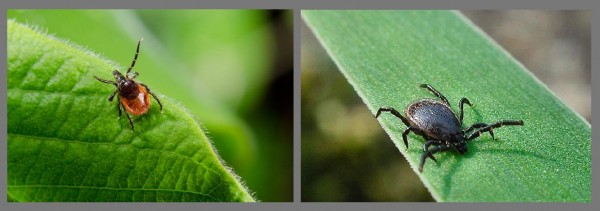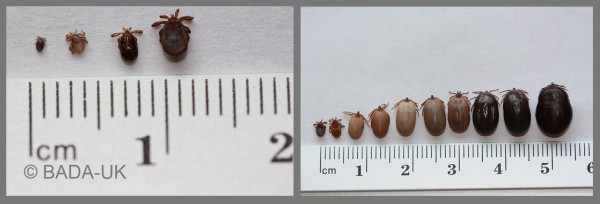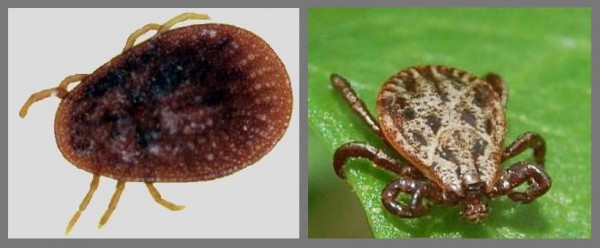This page covers the basic facts about ticks in the UK. For detailed information follow the links at the end of this page.
What is a tick?
Ticks are large acarids (phylum Arthropoda).
Due to their feeding behaviour, ticks are extremely detrimental to both human and animal health. They inflict a huge amount of physical damage, and by doing so reduce the ability of the host to fend off other infections.
Wounds inflicted by tick bites are open to secondary bacterial and fungal infections, making them one of the most important vectors of pathogens affecting human, companion animals, and livestock.
The number of tick-borne pathogens has been steadily rising in recognition, and because of this fact, the health hazards associated with ticks have increased dramatically in recent years.
The evidence of Ticks and tick-borne diseases (TBD’s) in Europe has shown a wide distribution in expansion, which indicates that the interaction between ticks and hosts is more common than previously or generally recognized. Much of this expansion is due to tick habitat and the shift in landscape use, i.e. habitat structure of wildlife, climate change, and change in farming methods.
There is also proven and valid concern that TBD’s are being encouraged by pets travelling to and from the UK. It has been noticed that new diseases arriving in the UK, i.e. canine babesiosis, are on the increase, as are other diseases not normally seen here. The indiscriminate feeding habits of ticks means that they are a reservoir for multiple infections transmitted to humans and animals. Equally important in the equation are migratory birds.
Ixodes ricinus-borne diseases in humans;
Anaplasma phagocytophilum – previously known as granulocytotropic ehrlichiosis.
Francisella tularensis – Tularaemia.
Borrelia burgdorferi sensu lato – the agent of Borreliosis (Lyme) a multisystem disorder, early treatment is with antibiotics, but when not diagnosed soon enough the infections can lead to severe complications of the neurological system, heart, and joints.
Tick-borne encephalitis (TBE) – endemic in most European countries, including the Baltic States.
Babesia spp. – human babesiosis is a significant emerging tick-borne zoonotic disease. The species are many and include B. microti (a rodent species) and B divergens (a bovine species) and are the most prevalent agents of human babesiosis in the USA and Europe , respectively.
The two major families of Ticks are the Ixodidae (hard ticks). Hard ticks have a hard shield –like structure (scutum) found on their backs.
Argasidae (soft ticks). Soft ticks are transient feeders.
The family Ixodidae are important species of interest from a medical and veterinary point of view, most of which belong to the genera Ixodes.
Description
Ticks vary in colour (ranging from reddish to dark brown or black), and differ in size, depending on the species, age and sex of the tick, and whether it has fed.
Left- a female sheep tick. Right – a male sheep tick (images are much larger than life-size).
Tick sizes
Ticks are tiny until a blood meal is taken, at which stage they engorge. Once fed, nymphs or adult ticks resemble a grey, pink, or blue-black balloon, and often protrude from an animals hair/fur.
An unfed female is approximately 3mm, is small, oval, and flat, and when fully engorged can reach 11mm. Unfed males are smaller, at approximately 2.5mm and require smaller meals. Unfed nymphs are also smaller and measure approximately 1.5mm. The newly hatched larvae measure approximately 0.5mm. Larvae are capable of transmitting infections.

The tick’s life cycle
The six legged larvae stage is dependent on a feed to moult, and reach the nymph stage.
The nymph will need to feed and moult to reach adulthood. Both the nymphs and adult ticks have eight legs.
Ticks in the UK

There are two families of tick that can be found in the United Kingdom:
1. Argasidae – a ‘soft tick’ , so called because they have a spongy and wrinkled back, which extends like a hood over their mouth parts.
2. Ixodidae – a ‘hard tick’, so called because they have a hard plate-like shield that covers their backs. Unlike soft ticks, the mouth parts can be seen from above because the shield does not cover them.
As a hard tick feeds and swells up with blood, the shield on its back appears smaller and more towards its head.
There are many species of tick in each of these families. It is usually a species of hard tick that is found on domestic pets or people, although some soft ticks will bite, given the opportunity.
What ticks are a risk to people and pets?
Three particular species of argasidae are more likely to attach to people and their pets in the UK. Ixodes ricinus (sheep tick, wood tick, deer tick and castor bean tick).
Ixodes hexagonus (hedgehog tick).
Dermacentor reticulatus (ornate cow tick or marsh tick).
There are over 20 species of ticks in Britain, their abundance, dependent on the area, habitat, and surrounding wildlife.
Ticks are indiscriminate feeders, and are active for long periods, even at low temperatures.
Further details found by clicking on below links:-







